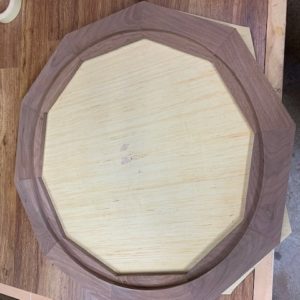I am making a 26″ round table top of walnut that features a 1″ thick segmented rim filled with 1/2″ straight boards glued to a 1/2″ plywood base. Should I be worried about expansion of the infill pieces causing the segments to possibly crack apart? Should I leave a small gap between the rim and the body of the table top?
Discussion Forum
Get It All!
UNLIMITED Membership is like taking a master class in woodworking for less than $10 a month.
Start Your Free TrialDiscussion Forum
Digital Plans Library
Member exclusive! – Plans for everyone – from beginners to experts – right at your fingertips.
Highlights
-
Shape Your Skills
when you sign up for our emails
This site is protected by reCAPTCHA and the Google Privacy Policy and Terms of Service apply. -
 Shop Talk Live Podcast
Shop Talk Live Podcast -
 Our favorite articles and videos
Our favorite articles and videos -
E-Learning Courses from Fine Woodworking
-
-
 Fine Woodworking New England Event
Fine Woodworking New England Event













Replies
Gluing boards to the plywood is definitely going to be a problem in itself. Have you noticed that there are always an odd number of plys in plywood.--so that the grain of the outside plys are in the same direction. Even when solid wood is veneered, an inexpensive veneer is put on the hidden or backside of the wood. This prevents cupping of the board.
Then there's the problem of expansion of the wood that is glued to the plywood. Significant forces are going to develop. The shear stress along the glue line could fail over time. ...or the plys could separate if the glue used in the plywood construction was of a poorer quality than what you use.
I do believe that the frame will crack apart if the centre is not allowed to float (expand and contract). You'll have to devise a way to allow for seasonal movement that won't transfer those forces to the frame.
I think that your best bet for the centre would be veneered plywood, even using thick veneer.
I use this type of construction and it is very stable, there is a rim around that goes cross grain with the top and there is no movement whatsoever. The Ratio I use is 3/4 inch plywood and 1/4 inch planks, preferably quarter sawn.
Great advice. Quarter sawn or rift sawn wood is very stable and would negate the need for a veneer on the underside of the plywood. 3/4 plywood and 1/4 inch veneer is a much better ratio than 1/2 ply, 1/2 cover boards. Using your ratio, he should use a covering of 1/6 inch (approx. 3/16 inch thick veneer). That stability would definitely prevent the frame from cracking.
Gulfstar is doing something completely different.
Generally speaking its a no-no to trap solid wood inside a frame. Even though its a series of 1/2" wide boards, the cumulative effect of all the little minute movements add up.
You might consider cutting the strips into veneer thickness and gluing them to a plywood or MDF substrate.
Everything I know and read about veneering says "why take the chance, veneer both sides." I've seen a 12X12 piece of 3/4 plywood warp when veneered on one side.
That said, I've seen many times theories of wood movement not prove to be an issue in the reality of the piece.
This forum post is now archived. Commenting has been disabled